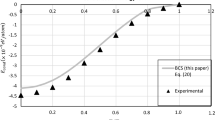Abstract
A model for superconductivity in thin films having variable thickness is derived through an averaging process across the film. When the film is of uniform thickness the model is identical to a model for superconducting cylinders as the Ginzburg-Landau parameter tends to ∞. This means that all superconducting materials, whether type I or type II in bulk, behave as type-II superconductors when made into sufficiently thin films. When the film is of non-uniform thickness the variations in thickness appear as spatially varying coefficients in the thin-film differential equations. After providing a formal derivation of the model, some results about solutions of the variable thickness model are given. In particular, it is shown that solutions obtained from the new model are an appropriate limit of a sequence of averages of solutions of the three-dimensional Ginzburg-Landau model as the thickness of the film tends to zero. An application of the variable thickness thin film model to flux pinning is then provided. In particular, the results of a numerical calculation are given that show that the vortex-like structures present in superconductors are attracted to relatively thin regions.
Similar content being viewed by others
References
R. A. Adams,Sobolev Spaces, Academic, New York 1975.
S. J. Chapman, Q. Du, M. D. Gunzburger and J. S. Peterson,Simplified Ginzburg-Landau type models of superconductivity in the high kappa, high field limit, Adv. Math. Sci. Appl.,5, 193–218 (1995).
S. J. Chapman, S. D. Howison and J. R. Ockendon,Macroscopic models of superconductivity. SIAM Rev.34, 529–560 (1992).
Q. Du, M. D. Gunzburger and J. S. Peterson,Analysis and approximation of the Ginzburg-Landau model of superconductivity. SIAM Rev.34, 54–81 (1992).
Q. Du, M. D. Gunzburger and J. S. Peterson,Solving the Ginzburg-Landau equations by finite element methods. Phys. Rev. B46, 9027–9034 (1992).
Q. Du, M. D. Gunzburger and J. S. Peterson,Finite element approximation of a periodic Ginzburg-Landau model for type-II superconductivity. Num. Math.64, 85–114 (1993).
V. Girault and P.-A. Raviart,Finite Element Methods for Navier-Stokes Equations. Springer, Berlin 1986.
L. P. Gor'kov and G. M. Éliashberg,Generalisation of the Ginzburg-Landau equations for non-stationary problems in the case of alloys with paramagnetic impurities. Soviet Phys. J.E.T.P.27, 328–334 (1968).
G. Lasher,Mixed state of type-I superconducting films in a perpendicular magnetic field. Phys. Rev.154, 345–348 (1967).
O. A. Ladyzhenskaya,The Mathematical Theory of Viscous Incompressible Flow. Gordon and Breach, New York 1969.
J. D. Livingston and W. Desoro,The intermediate state in type I superconductors, inSuperconductivity, ed. by R. D. Parks, Marcel Dekker, New York 1969, pp. 1235–1281.
K. Maki,Fluxoid structure in superconducting films. Ann. Phys.34, 363–376 (1965).
M. Tinkham,Effect of fluxoid quantization on transitions of superconducting films. Phys. Rev.129, 2413–2422 (1963).
M. Tinkham,Consequences of fluxoid quantization in the transitions of superconducting films. Rev. Mod. Phys.36, 268–276 (1964).
M. Tinkham,Introduction to Superconductivity. McGraw-Hill, New York 1975.
Author information
Authors and Affiliations
Additional information
Supported by British Nuclear Electric Fuels Research Fellowship.
Supported by the Department of Energy under grant number DE-FG02-93ER25172.
Supported by the Department of Energy under grant number DE-FG05-93ER25175.
Rights and permissions
About this article
Cite this article
Chapman, S.J., Du, Q. & Gunzburger, M.D. A model for variable thickness superconducting thin films. Z. angew. Math. Phys. 47, 410–431 (1996). https://doi.org/10.1007/BF00916647
Received:
Revised:
Issue Date:
DOI: https://doi.org/10.1007/BF00916647




